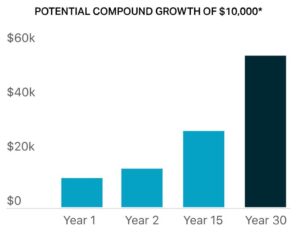One of the simplest and most effective ways to save for retirement is through your workplace retirement plan. Many financial professionals recommend saving 10% to 15% of your total income. Yet how much you should save largely depends on your retirement goals, age, and income.
Age may be the most important factor. The earlier you start, the more time your money has to work — so you generally can begin with a smaller amount and work your way up over time. The closer you are to retirement when you start saving, the more you’ll need to put away to reach your goals.
Value of Investing Today
One of the most powerful principles of investing is compound returns. Compounding enables you to earn an investment return on your initial account deposit and on prior years’ investment returns. And the more time you allow your money to work, the more it compounds, which makes it best to start saving early.
Let’s look at a simple example:

- Year 1: You invest $10,000 and earn 6% ($600), bringing your balance to $10,600
- Year 2: Your balance of $10,600 earns 6% ($636) bringing your new balance to $11,236
- Year 15: Assuming 6% compound returns for 15 years, your account balance would be $23,966
- Year 30: Assuming 6% compounded returns for 30 years, your account balance would be more than $57,000!
Tax Advantages
Fortunately, you don’t have to wait until retirement to realize the benefits of saving now. With the exception of Roth IRA contributions, which are made with after-tax dollars, money you contribute to your retirement plan is considered pre-tax, meaning you don’t pay taxes on them today. This lowers your current taxable income. Plus, your contributions and any earnings accumulate tax-deferred, so you won’t pay taxes until you withdraw the money. When you do take assets from your account — ideally as a retiree — they will be taxed as regular income, when you may be in a lower tax bracket.
Yearly Contribution Limits
Each year, the IRS sets limits on how much savers can contribute to their retirement savings accounts. If you’re over 50 — or are turning 50 by the end of the year — you can make additional catch-up contributions. This can be a great way to bulk up your savings if you expect to (or have already) met your plan’s limit for the year. A reminder that SEP IRAs are employer-funded, and do not allow employee contributions of any kind.
2023 IRS Contribution Limits
401(k), 403(b) & 457(b) Limits
- Basic Contribution Limit (under 50) $22,500
- Catch-up Contribution (age 50+) $7,500
- Total Contribution Limit (age 50+) $30,000
SIMPLE IRA Limits
- Basic Contribution Limit (under 50) $15,500
- Catch-up Contribution (age 50+) $3,500
- Total Contribution Limit (age 50+) $19,000
While there are limits to how much you can contribute to your account each year, employer matches don’t count toward that limit. If your employer matches a percentage of your contribution, most financial professionals recommend that you invest at least as much as your company is willing to match – otherwise you’re leaving free money on the table.
The Takeaway
There’s more than one way to reach your retirement goals, whatever your age or income. If you’re not yet saving as much as you’d like, you can increase your contribution rate over time, or when your budget allows. While there are no shortcuts to a secure retirement, investing in your retirement plan means you’re on the right path.
*The investment performance shown is for educational purposes only and does not represent the return of any particular investment or guarantee any future rate of return.

